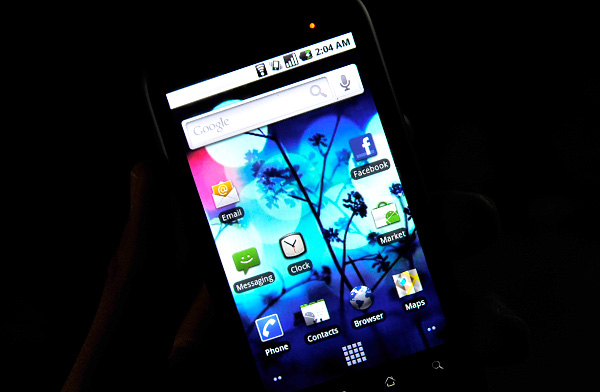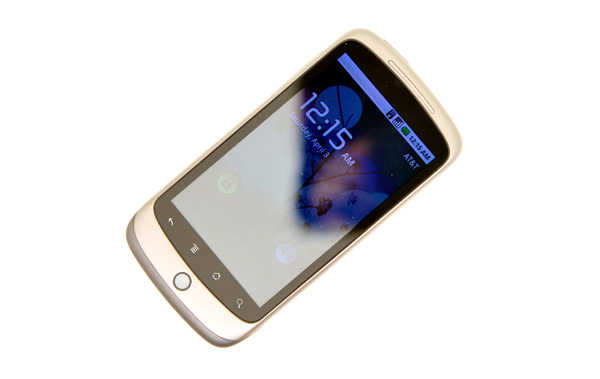Anand's Google Nexus One Review
by Anand Lal Shimpi on April 3, 2010 3:40 AM EST- Posted in
- Smartphones
- Mobile
The Display, My Love, the Display
If there’s one aspect of the Nexus One that makes the iPhone 3GS feel really dated it’s the display. Let’s look at the basic specs:
| Google Nexus One vs. Apple iPhone | |||||
|
Apple iPhone 3GS (ARM Cortex A8)
|
Google Nexus One (Qualcomm Snapdragon QSD8250)
|
||||
| Screen Technology | LCD | Active Matrix OLED | |||
| Screen Diagonal | 3.5" | 3.7" | |||
| Resolution | 320 x 480 | 480 x 800 | |||
| Pixels per Inch | 163 ppi | 252 ppi | |||
For very similar screen sizes (the Nexus One is narrower but longer than the iPhone), Google offers a huge increase in resolution. It makes sense given that the iPhone 3GS is still using the same resolution panel as the first iPhone back in 2007.
Recently Luke Hutchison published an excellent article at Ars Technica explaining the subpixel makeup of the Nexus One’s display. Most display technologies we’re used to reproduce colors by using a combination of red, green and blue. Instead of evenly distributing RGB subpixels across the display, the Nexus One has a combination of RRG or GBB for each pixel. This optimization is put in place most likely to reduce manufacturing cost or increase lifespan of the display.
Either way, you’re not getting complete color data on a per pixel basis. Now I won’t get into the argument of whether or not Google should call it a 480 x 800 display. It technically has that many pixels, it’s just that their makeup is a bit odd.

Google also does some pretty standard tricks to make the display look even more impressive. You get oversaturated colors and the usual trickery you can find in the TV section at Best Buy. Whites on the Nexus One aren't quite white but rather a cool blue and reds are often too red.
Compared to the iPhone, indoors, the Nexus One display is just incredible. If there are two things you could describe the Nexus One display as they would be: high contrast, and sharp. Indoors, and above 50% brightness, it’s honestly the best looking display I’ve ever seen on a smartphone. The colors are ridiculously vibrant and they pop because of the super deep blacks.

It really looks that contrasty.
The AMOLED display has no backlight, and thus it’s far more power efficient to display lots of black than it is to display bright whites. For this reason many of the applications use black backgrounds. For example, here’s the email app in Android vs. the email app in iPhone OS:
|
Google Nexus One
|
Apple iPhone 3GS
|
 |
 |
Given that Android is a fairly mainstream OS and not a pornsite, white text on a black background is generally unexpected. Unexpected, but not more difficult to read. The high resolution and incredibly contrasty AMOLED display make sure of that.

In direct sunlight, the lower part of the picture above is what the Nexus One looks like
Outdoors it’s another story entirely. In direct sunlight, the display is mostly useless at its default brightness settings. With the brightness cranked all the way up it’s still washed out but at least legible. Which brings me to my next point. The auto brightness control on the Nexus One is frustrating.

It automatically adjusts display brightness based on ambient light, but it generally picks a brightness that’s too low for my tastes. I just ended up disabling the automatic control and picked something that was around 50 - 100% brightness depending on what I was doing with the phone. I would like the option to have the auto brightness control pick settings that are a little less conservative.
Touch the Screen
Touchscreens have gotten much better over the past couple of years since the iPhone’s introduction. The Nexus One’s touchscreen is very close to as responsive as the iPhone’s but with some annoying issues. There are some situations where holding the Nexus One in one hand and swiping with my thumb won’t let me swipe between screens, and other similar accuracy issues. Getting the home bar buttons to recognize taps is also a pain at times. The touchscreen is definitely usable, just not as good as the iPhone's.










95 Comments
View All Comments
bjacobson - Monday, April 5, 2010 - link
Motorola Droid is no better, my friend has one and OC'd his processor to 1.1Ghz and it still lags just as badly. Both choppy and lags where my finger is. I don't like it at all. This is the main reason I haven't even considered the Android platform yet. I probably will when they fix this.LongTimePCUser - Wednesday, April 14, 2010 - link
Have you tried the Moto Droid after the Android 2.1 upgrade?My experience was that the ui seemed smoother and faster after the upgrade.
eva2000 - Monday, April 5, 2010 - link
bummer about battery life, sounds like nexus rev2 with 1700-1800mah battery in the near future hehhugov - Tuesday, April 6, 2010 - link
I'm not sure the Adreno 200 is as far behind the SGX530/535 as you suggest. The iPhone 3Gs chip (Samsung S5PC100) states in the docs (http://www.samsung.com/global/business/semiconduct... that the GPU is capable of up to 10M triangles/sec, a far cry from the 28M reported in popular press recently. QSD8250 docs suggest up to 22M triangles. And the Adreno is a unified shader architecture GPU with no fixed-function pipes, similar to the PowerVR SGX. OTOH, the *drivers* appear to be quite lacking compared to the PowerVR drivers, at least on Linux/Android.TheHolyLancer - Tuesday, April 6, 2010 - link
I mean wow that dog seems to be focused directly on something above the camera, is that a treat or something?ThePooBurner - Wednesday, April 7, 2010 - link
I really enjoyed reading through this review. I have been wanting to move to a smart phone, but haven't been able to decide what i want. This helps put android devices into perspective in terms of what they can do and what i can expect. I happen to abhor apple, and so i will never own an iphone. I can't stand closed platforms or someone else telling me what i can and can't do with a device that i own. Their stance on "jail-breaking" sickens me. It's like telling me i can't put a new engine in my car if i want to. But that is besides the point. Windows P7 looks like it might be good, but that is a ways off. The Pre-pro looks the most appealing of the phones i have seen reviewed.However, there are 2 devices that i would love to see added to the list of reviewed smart phones: The Nokia n900, and the Samsung Omnia II. For the n900, I would love for you to do a review of it and show us what the Maemo platform can do, as well as a quantifiable battery life test. The phone can do just about everything, but knowing how much doing all of that affects the battery life would be great. The device from a hardware standpoint isn't that different from some of the other smart phones out. It's an Cortex A8 at 600mhz. It's got 32GB of storage (expandable to 48), 5mp camera with flash, WiFi, BT, and it also has an FM transmitter. So on paper it looks great, but there haven't really been any solid reviews on the device from good review sites that use quantifiable testing, or from non-marketing type sites. I know that it also has integration with google voice and google chat. The Omnia 2 has an 800Mhz CPU, and a lot of the same hardware features and uses the TouchWiz 2.0 WM6.5 GUI, which appears to be samsung's platform of choice going forward. It's fairly new so there isn't a whole lot of information out there on this phone yet, but it seems to be marketed as the flagship product from samsung at the moment.
Do you think that you could review these for us? From what i have seen they both look pretty good (though the N900 looks better), but 600$ is a lot to spend without having more than marketing to go off of.
If nothing else this article has at least brought me up to speed on android and it's benefits.
pepsi_max2k - Wednesday, April 7, 2010 - link
"For example, typing yjomh instead of thong won’t autocorrect, although on the iPhone it will. "And I think I speak for everyone, Anand, when I say: Under what situation did you actually find this highly intriguing piece of information out?
SuperFly03 - Thursday, April 8, 2010 - link
Ugh, this review is full of misinformation. I had to say something.http://forum.xcpus.com/blogs/superfly03-341.htm
coolVariable - Thursday, April 8, 2010 - link
1. No mention of the lacking exchange sync.2. No mention of the lacking copy & paste within emails
3. No mention of the connectivity issues.
4. No mention of attachment issues (sending or saving).
5. No mention of file download issues.
...
What a BAD review.
SuperFly03 - Friday, April 9, 2010 - link
I'm not sure what Google phone you are using but the only problem I've had is no. 2. You can't copy paste within emails. I do believe that is a silly limitation but I do not think it is a big problem in the grand scheme of things.No. 1 is complete BS. I have been hooked into my exchange account since day 1 and have never had any issues.
No. 3 is about as generic as you can get. I realize it is a problem that is on the Google sub-forums but likely a firmware issue not an Android issue.
No. 4 and 5 is just laughable.